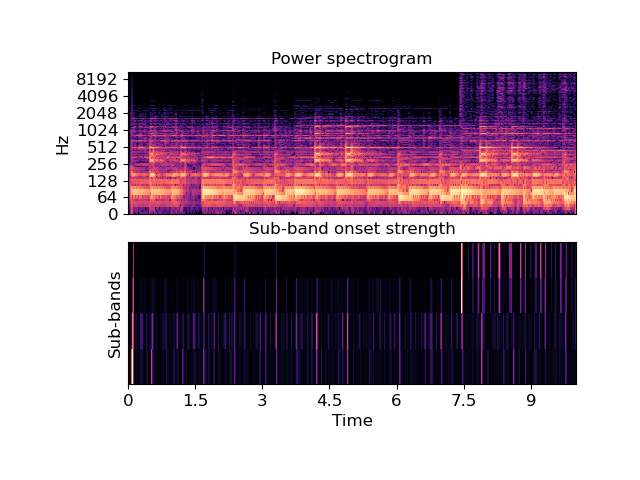Caution
You're reading an old version of this documentation. If you want up-to-date information, please have a look at 0.9.1.
librosa.onset.onset_strength_multi¶
- librosa.onset.onset_strength_multi(y=None, sr=22050, S=None, n_fft=2048, hop_length=512, lag=1, max_size=1, ref=None, detrend=False, center=True, feature=None, aggregate=None, channels=None, **kwargs)[source]¶
Compute a spectral flux onset strength envelope across multiple channels.
Onset strength for channel i at time t is determined by:
mean_{f in channels[i]} max(0, S[f, t+1] - S[f, t])
- Parameters
- ynp.ndarray [shape=(n,)]
audio time-series
- srnumber > 0 [scalar]
sampling rate of y
- Snp.ndarray [shape=(d, m)]
pre-computed (log-power) spectrogram
- n_fftint > 0 [scalar]
FFT window size for use in feature() if S is not provided.
- hop_lengthint > 0 [scalar]
hop length for use in feature() if S is not provided.
- lagint > 0
time lag for computing differences
- max_sizeint > 0
size (in frequency bins) of the local max filter. set to 1 to disable filtering.
- refNone or np.ndarray [shape=(d, m)]
An optional pre-computed reference spectrum, of the same shape as S. If not provided, it will be computed from S. If provided, it will override any local max filtering governed by max_size.
- detrendbool [scalar]
Filter the onset strength to remove the DC component
- centerbool [scalar]
Shift the onset function by n_fft / (2 * hop_length) frames
- featurefunction
Function for computing time-series features, eg, scaled spectrograms. By default, uses
librosa.feature.melspectrogramwith fmax=11025.0Must support arguments: y, sr, n_fft, hop_length
- aggregatefunction or False
Aggregation function to use when combining onsets at different frequency bins.
If False, then no aggregation is performed.
Default:
np.mean- channelslist or None
Array of channel boundaries or slice objects. If None, then a single channel is generated to span all bands.
- kwargsadditional keyword arguments
Additional parameters to feature(), if S is not provided.
- Returns
- onset_envelopenp.ndarray [shape=(n_channels, m)]
array containing the onset strength envelope for each specified channel
- Raises
- ParameterError
if neither (y, sr) nor S are provided
See also
Notes
This function caches at level 30.
Examples
First, load some audio and plot the spectrogram
>>> import matplotlib.pyplot as plt >>> y, sr = librosa.load(librosa.util.example_audio_file(), ... duration=10.0) >>> D = np.abs(librosa.stft(y)) >>> plt.figure() >>> plt.subplot(2, 1, 1) >>> librosa.display.specshow(librosa.amplitude_to_db(D, ref=np.max), ... y_axis='log') >>> plt.title('Power spectrogram')
Construct a standard onset function over four sub-bands
>>> onset_subbands = librosa.onset.onset_strength_multi(y=y, sr=sr, ... channels=[0, 32, 64, 96, 128]) >>> plt.subplot(2, 1, 2) >>> librosa.display.specshow(onset_subbands, x_axis='time') >>> plt.ylabel('Sub-bands') >>> plt.title('Sub-band onset strength') >>> plt.show()
